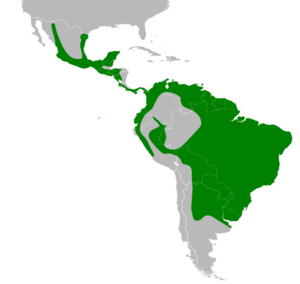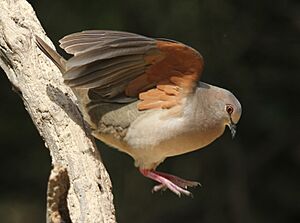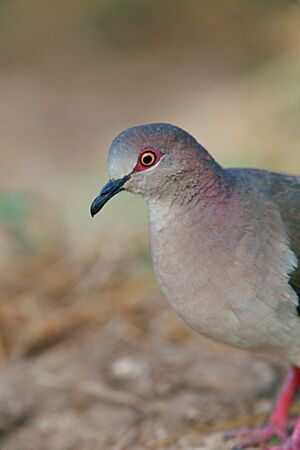White-tipped dove facts for kids
Quick facts for kids White-tipped Dove |
|
|---|---|
 |
|
| Conservation status | |
| Scientific classification | |
| Genus: |
Leptotila
|
| Species: |
verreauxi
|
 |
|
The White-tipped Dove (Leptotila verreauxi) is a large tropical dove found in the Americas. It got its scientific name from two French naturalists, Jules and Edouard Verreaux.
Where They Live
This dove lives in many places, from the very southern part of Texas in the United States, all the way through Mexico and Central America. You can find them south to western Peru and central Argentina. They also live on islands off the coast of northern South America, like Trinidad and Tobago and the Netherlands Antilles. They like to live in bushy areas, woodlands, and forests.
Scientists have identified several different types of White-tipped Doves, each with slight differences depending on where they live.
What They Look Like
The White-tipped Dove is about 28 centimeters (11 inches) long. It weighs around 155 grams (5.5 ounces), which is about as much as a small apple.
Most adult doves have a grey color on their head, from the top down to their neck. Their forehead is usually pale grey or whitish, and their throat is white. The ring around their eye is often red, but in some parts of the Amazon and northern South America, it can be blue.
Their back and wings are grey-brown. Their belly is whitish, changing to pinkish or a dull grey on their chest. The feathers under their wings are a reddish-brown color. Their tail has a wide white tip, which is easiest to see when they are flying or from underneath. They have a black beak and red legs. Their eyes are yellow.
The White-tipped Dove looks a lot like its cousin, the grey-fronted dove. However, the White-tipped Dove usually has a greyer forehead and crown. This makes its head color blend in more with the back of its head.
How They Behave
White-tipped Doves are usually seen alone or in pairs. They are quite careful and shy. They tend to stay in their home area and do not fly to different places for the seasons. When they fly, it's fast and straight. Their wings make a flapping sound, which is common for pigeons and doves. They live in many different kinds of wooded areas.
Vocal Calls
These doves use their voices for many reasons. They call to protect their territory, to find a mate, to show where food is, to warn others about dangers, and to stay in touch with other doves.
Their special call has two notes at the same sound level. It starts with a soft hoot, then a longer, clearer, hollow sound.
Reproduction
White-tipped Doves build a large nest out of sticks. They usually build it in a tree, not too far from the ground. The female lays two white eggs. The eggs hatch in about 14 days. The young doves are ready to leave the nest about 15 days after they hatch.
What They Eat
These doves mostly eat seeds that they find on the ground. But they also like to eat insects, including butterflies and moths.





